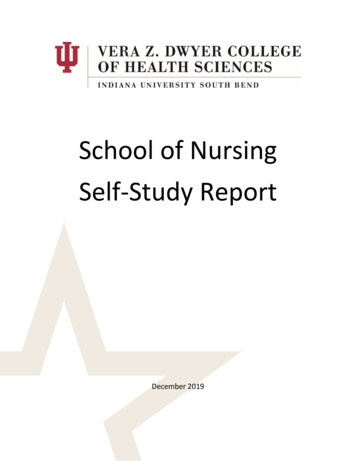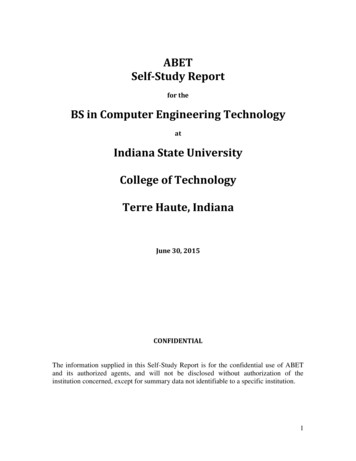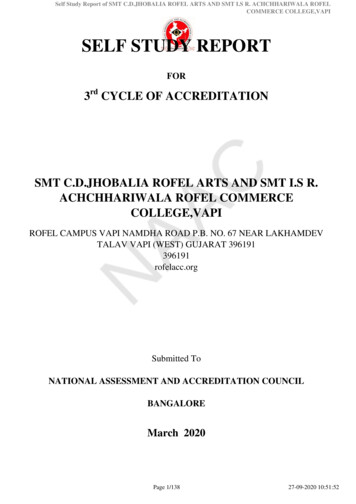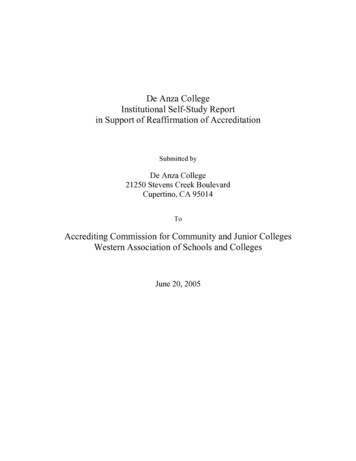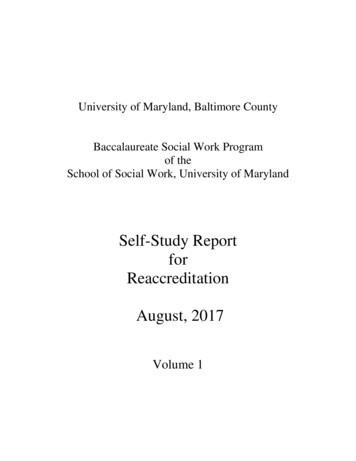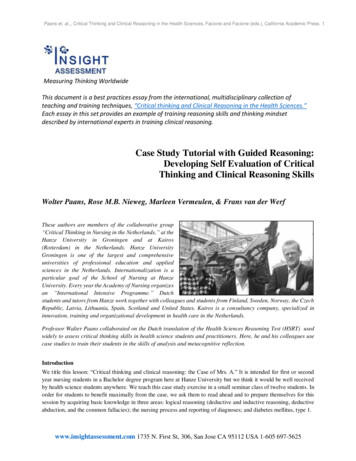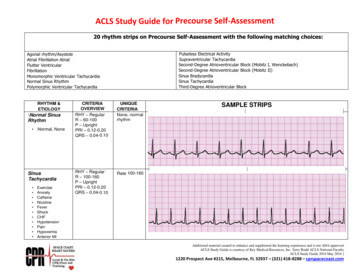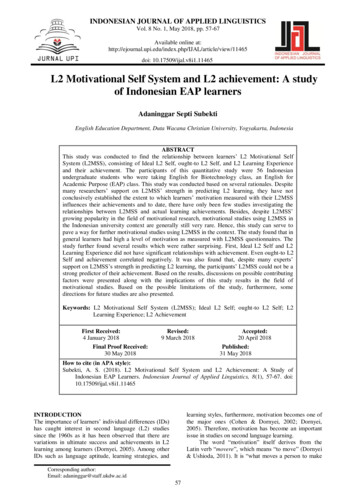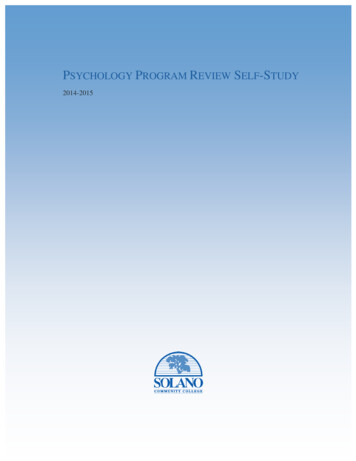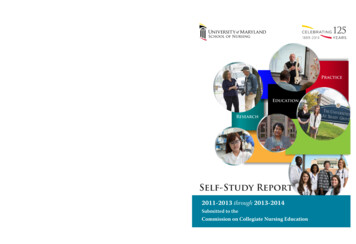
Transcription
PracticeEducationResearchSelf-Study Report2011-2013 through 2013-2014Submitted to theCommission on Collegiate Nursing Education
sfdagasdfg
TABLE OF CONTENTSIntroductionStandard I: Program Quality: Mission and GovernanceI-AI-BI-CI-DI-EI-FStandard II: Program Quality: Institutional Commitment and ResourcesII-AII-BII-CII-DII-EII-FStandard III: Program Quality: Curriculum, Teaching-Learning tandard IV: Program Effectiveness: Assessment and Achievement ofProgram ii
sfdagasdfg
IntroductionThe University System of MarylandThe University System of Maryland (USM) comprises 12 institutions, two regional higher education centers, anda system office. USM creates a dynamic educational environment that supports a unique array of dual-degreeprograms; fosters groundbreaking research, innovation, and entrepreneurship; and fuels the engine that ishelping to power Maryland forward. As a public system of higher education, USM advances the state ofMaryland and benefits all of society. Worldwide, the USM enrolls 111,141 undergraduate students and 42,238graduate and professional students (see a list of USM Schools in Appendix Intro-1).The University of Maryland, BaltimoreThe University of Maryland, Baltimore (UMB) is one of the 12 USM institutions. Founded in 1807, UMB isMaryland's only public academic health, human services, and law center. Its 61-acre educational, research, andtechnology complex consists of six professional schools and an interdisciplinary graduate school that educatethe majority of the state’s physicians, nurses, dentists, lawyers, social workers, and pharmacists (see theorganizational chart for UMB in Appendix Intro-2). Adjacent to the campus are the University of MarylandMedical Center, the Baltimore Veterans Affairs Medical Center, and the University of Maryland BioPark. TheBioPark, which opened in 2005, promotes collaborative research opportunities and bioscience innovation.The campus is a national leader in health sciences research, with 479.8 million in grants and contracts in FY2013. Its 6,368 students and 6,875 faculty and staff members help make UMB a powerful economic engine thatreturns more than 15 in financial activity for every dollar invested in it by the state. The UMB communitycontributes more than two million hours a year in service to the public.The Commission on Higher Education of the Middle States Association of Colleges and Schools first accreditedUMB in 1921. The most recent onsite evaluation was in April 2006. At its June 22, 2006 session, the Commissionacted to reaffirm accreditation and to commend UMB for the quality of its self-study report and process. Thenext evaluation is due in 2016. As a state institution, UMB’s duty to serve the public good is at the heart of itsmission. UMB is committed to ensuring that the knowledge it generates provides maximum benefit to society,directly enhancing the community.The University of Maryland School of NursingThe University of Maryland School of Nursing (UMSON), established in 1889, is the largest nursing school inMaryland and one of the largest in the nation. UMSON enrolls 1,700 students, including more than 200 studentsat the Universities at Shady Grove (USG) in Rockville, Md. USG, Maryland’s largest regional center, is apartnership of nine USM universities on one campus in Montgomery County. UMSON is ranked 11th among allnursing schools nationally by U.S.News & World Report. UMSON develops strong leaders who shape theprofession of nursing and have a powerful impact on the health care environment. The concepts of leadership,partnership, and innovation are fundamental to all of UMSON’s academic and clinical pursuits.Dean Jane M. Kirschling is UMSON’s chief administrative officer and reports to the President of UMB. Theassociate dean for research, the associate dean for development and alumni relations, the associate dean forstrategic partnerships and initiatives, and the two department chairs report directly to the Dean. All facultymembers belong to one of the two departments: Organizational Systems and Adult Health, and Family andCommunity Health (see the UMSON organizational chart in Appendix Intro-3).Consistent with the mission of UMB, UMSON is dedicated to creating a research-intensive environment that willadvance the science of nursing through research and scholarship of the highest quality. Currently, UMSON isranked 9th among schools of nursing in receipt of funding from the National Institutes of Health (NIH)/NationalInstitutes of Nursing Research, and attracted 4.4 million in NIH/NINR grants in 2013. UMSON received morethan 11.2 million in extramural funding in FY 2013.UMSON offers an upper division undergraduate program that leads to the Bachelor of Science in Nursing (BSN)degree. The BSN Program provides educational opportunities for people just entering the nursing profession1
and for registered nurses with an associate degree or diploma in nursing who want to advance their academicqualifications. UMSON students in the BSN and RN-BSN Programs have the ability to attend courses andcomplete the entire program at the USG site. The BSN Program prepares nurses with a liberal arts educationwho are equipped with clinical knowledge, technological expertise, proficiency in scientific and clinicaldecision-making, critical thinking abilities, and humanistic skills. Graduates of the program are well positionedto play a significant role in shaping the future of nursing and health care by assuming direct care providerroles.UMSON has pioneered a variety of innovative graduate programs, including the world’s first nursing informaticsmaster’s specialty, Maryland’s only nurse anesthesia program for civilians, the first clinical nurse leadermaster’s option, and the first Doctor of Nursing Practice Program. The MS Program has included specialties ininformatics, community/public health nursing, health services leadership and management, and six AdvancedPractice Registered Nurse (APRN) options: Nursing Anesthesia, Adult and Gerontological Primary Care NursePractitioner, Adult and Gerontological Acute Care Nurse Practitioner/Clinical Nurse Specialist, Family NursePractitioner, Pediatric Acute or Primary Care Nurse Practitioner, and Psychiatric Nurse Practitioner FamilyFocus. The School also has a Maryland Higher Education Commission-approved Post-Master’s APRN CertificateProgram designed to assist RNs who have MS degrees in nursing in acquiring the knowledge and clinicalexperience that will prepare them to sit for the certification exam as an Adult and Gerontology Primary CareNurse Practitioner, Acute Care Nurse Practitioner/Clinical Nurse Specialist, Family Nurse Practitioner, PediatricAcute or Primary Care Nurse Practitioner, or Psychiatric Mental Health Nurse Practitioner Family Focus.UMSON’s Post-Master’s Doctor of Nursing Practice (DNP) Program began in the fall 2006 semester and has beengeared toward nurse executives, informaticians, educators, clinical nurse specialists, nurse anesthetists, andnurse practitioners with MS degrees in nursing. The DNP Program prepares graduates to lead at the highesteducational, clinical, and executive ranks. DNP graduates are experts in the evaluation and application ofevidence for the improvement of education, clinical practice, and systems management. In the fall 2014semester, UMSON will be opening two additional DNP options for Advanced Practice Registered Nurse (APRN)students: a Post-BSN to DNP and a DNP with Specialties (Post-Master’s). BSN-prepared APRN applicants will nolonger be admitted to the MS Program, but will seek a DNP degree.UMSON’s PhD Program, launched in 1979, prepares scholars and researchers who will advance nursing scienceand provide innovative leadership in the profession. The program design allows students to study thetheoretical and empirical bases for nursing practice in a variety of clinical settings, nursing education,administration, and/or policy. Personal research interests, career goals, and the match with faculty expertisedetermine the emphasis area chosen by students. Depth of knowledge in the emphasis area is developedthrough required coursework and related clinical laboratory experience, selection of support electives,independent study, and dissertation research.UMSON offers a variety of flexible and combined accelerated degree options. These include a RN-BSN, a postbaccalaureate entry option into the PhD Program, and dual degree MS/MBA and PhD/MBA Programs (inconjunction with the University of Baltimore and the Robert H. Smith School of Business, University of MarylandCollege Park). All nursing graduate students (MS, DNP, and PhD) also have the opportunity to enroll in the MS,DNP, or PhD/MPH dual degree program to prepare them for a more diverse range of careers in nursing andpublic health . The MPH Program is offered through theDepartment of Epidemiology and Public Health in the University of Maryland School of Medicine. The MS/MPHdual degree program can usually be completed in one additional semester if the student is enrolled full time.UMSON has an office that focuses on building strategic relationships across the tripartite mission. The Office ofStrategic Partnerships and Initiatives (SPI) advances UMSON’s mission by building external partnerships foreducation, research, and practice that achieve the School’s strategic goals. SPI is comprised of the offices ofprofessional education, clinical enterprise, and legal and contractual services.The clinical education of students requires UMSON to maintain affiliations with hundreds of hospitals andhealth care agencies throughout Maryland and other states. In addition, UMSON’s 154,000-square-foot buildingon the Baltimore campus and facilities at the USM regional higher education site at Shady Grove offer thelatest in research and instructional facilities. State-of-the-art clinical simulation laboratories at both locationsafford students extensive hands-on experiences that mimic hospital and home environments.2
The Office of Professional Education (OPE) is an accredited provider of American Nurses Credentialing Center(ANCC) continuing professional nurse education that offers innovative and creative continuing education,conferences, and workshops for nurses, faculty members, staff, alumni, partner organizations, and students.OPE has been an accredited provider since 1991 and was reaccredited by ANCC for four years (2013 to 2017).OPE is widely recognized, in particular, for the international Summer Institute in Nursing Informatics, whichjust completed its 24th year; the annual Evidence-based Practice Conference from 2003 to 2012; and theKnowledge Utilization Conference in conjunction with the international association in 2013. OPE providesonsite as well as Web-based programs accessible to nurses worldwide. The office develops online professionaleducation courses that support the advancement of professional nursing. This approach to self-study andindividualized learning enables a high level of engagement with professional nurses and other interprofessionalcolleagues to advance contemporary nursing practice.The Office of Clinical Enterprise administers the Governor’s Wellmobile program, a public/private partnershipfor both education of nurses and faculty practice. The program receives core funding through an annual Stateof Maryland legislative allocation from the Maryland Higher Education Commission (MHEC). This funding isleveraged to obtain other funding to support the program. The Governor’s Wellmobile program has twomissions: 1) to serve the health needs of the underserved in the State of Maryland by providing primary careand nurse-managed care coordination and outreach, and 2) to serve as a clinical site for nursing students incommunity public health and advanced practice nursing students’ preceptorships. Additionally, the Wellmobileprogram is an interprofessional practice site in collaboration with the University of Maryland School of SocialWork faculty practice and students. The significance of this educational mission is underscored by new federalhealth care reform legislation, which emphasizes prevention, public health, and enhancement of the primarycare infrastructure. The latter is particularly relevant to mitigation of health care work force shortages in thestate and region.AccreditationUMSON attained its initial accreditation from CCNE in 2009 for the Bachelor of Science in Nursing, Master ofScience, and Doctor of Nursing Practice Programs. This self-study is for reaccreditation of the BSN, MS, andDNP Programs, and for an initial accreditation of the Post-APRN Master’s Certificate Program.3
sfdagasdfg
Standard IProgram Quality: Mission and GovernanceThe mission, goals, and expected program outcomes are congruent with those of the parent institution, reflectprofessional nursing standards and guidelines, and consider the needs and expectations of the community ofinterest. Policies of the parent institution and nursing program clearly support the program’s mission, goals,and expected outcomes. The faculty and students of the program are involved in the governance of theprogram and in the ongoing efforts to improve program quality.I-A. The mission, goals, and expected program outcomes are: congruent with those of the parent institution; and consistent with relevant professional nursing standards and guidelines for the preparation ofnursing professionals.Elaboration: The program’s mission statement, goals, and expected program outcomes are written andaccessible to current and prospective students, faculty, and other constituents. Program outcomes includestudent outcomes, faculty outcomes, and other outcomes identified by the program. A mission statementmay relate to all nursing programs offered by the nursing unit or specific programs may have separatemission statements. Program goals are clearly differentiated by level when multiple degree/certificateprograms exist. Student outcomes may be expressed as competencies, objectives, benchmarks, or otherterminology congruent with institutional and program norms.The program identifies the professional nursing standards and guidelines it uses. CCNE requires, asappropriate, the following professional nursing standards and guidelines: The Essentials of Baccalaureate Education for Professional Nursing Practice [American Association ofColleges of Nursing (AACN), 2008]; The Essentials of Master’s Education in Nursing (AACN, 2011); The Essentials of Doctoral Education for Advanced Nursing Practice (AACN, 2006); and Criteria for Evaluation of Nurse Practitioner Programs [National Task Force on Quality NursePractitioner Education (NTF), 2012].A program may select additional standards and guidelines.A program preparing students for certification incorporates professional standards and guidelinesappropriate to the role/area of education.An APRN education program (degree or certificate) prepares students for one of the four APRN roles andin at least one population focus, in accordance with the Consensus Model for APRN Regulation:Licensure, Accreditation, Certification and Education (July 2008).Program Response:The mission of UMSON is to shape the profession of nursing and the health care environment by developingleaders in education, research, and practice. The mission was reviewed and re-affirmed as part of the UMSONstrategic planning process in 2012 and it guides UMSON’s Strategic Plan for 2012-2017. The robustbaccalaureate, graduate, doctoral, and research programs strive to meet the mission and remain innovative intheir approaches. The missions of the University System of Maryland (USM), the University of Maryland,Baltimore (UMB), and UMSON are provided in Appendix IA-1. UMSON’s mission is congruent with the missions ofUMB and USM (see Appendix IA-2).For this school of nursing, program outcomes are equivalent to student learning outcomes. Program outcomesfor the Bachelor of Science in Nursing (BSN), Master of Science (MS), and Doctor of Nursing Practice (DNP)Programs are listed below.BSN Program Outcomes4
Graduates of the BSN Program are prepared to: Combine theoretical knowledge from the sciences, humanities, and nursing as a foundation toprofessional nursing practice that focuses on health promotion and prevention of disease for individuals,families, communities, and populations Use the nursing process to manage care for individuals, families, communities, and populationsintegrating physical, psychological, social, cultural, spiritual, and environmental considerations Integrate competencies in leadership, quality improvement, and patient safety to improve health andpromote interdisciplinary care Use the research process through translation of evidence-based findings to advance professional nursingand the delivery of health care Incorporate information management and patient care technology in the delivery of quality patientcentered care Integrate knowledge of health care policy from social, economic, political, legislative, and professionalperspectives to influence the delivery of care to individuals, families, communities, and populations Employ interprofessional communication and collaboration to ensure safe, quality care across thelifespan Use principles of ethics, legal responsibility, and accountability to guide professional nursing practiceacross the lifespan and across the health care continuum Accept personal accountability for lifelong learning, professional growth, and commitment to theadvancement of the professionMaster’s Program OutcomesGraduates of the MS Program are prepared to: Incorporate scientific inquiry and theoretical concepts into efforts to improve the care to individuals andcommunities Lead evidence-based and interprofessional approaches for the design and delivery of comprehensive,culturally competent care to individuals/families, communities, and populations Participate in the design, implementation, and evaluation of health care systems to foster safety andexcellence in health care delivery Engage in ethically sound, culturally sensitive, and evidenced-based practice to promote the health ofindividuals and communities Commit to lifelong learning for self and promote lifelong learning to consumers Practice advanced nursing roles in collaborative relationships across disciplines and in partnership withcommunities, i.e., nursing education, nursing administration, nursing informatics, advanced clinicalpractice, and clinical nursing leadershipDNP Program OutcomesGraduates of the DNP Program are prepared to: Initiate, facilitate, and participate in collaborative efforts that influence health care outcomes withscholars, practitioners, clinicians, and policy makers from other disciplines Lead at the highest educational, clinical, and executive ranks Evaluate and apply ethically sound, culturally sensitive, evidence-based practice for the improvement ofeducation, clinical practice, systems management, and nursing leadership Analyze and apply scientific knowledge and related skills for the highest level of nursing practice Design, implement, manage, and evaluate patient care and organizational systemsThese program outcomes are consistent with the missions of UMB and UMSON (see Appendix IA-3).The program outcomes for UMSON’s BSN, MS, and DNP Programs are derived from standards defined by theAmerican Association of Colleges of Nursing (AACN) in their publications: The Essentials of BaccalaureateEducation for Professional Nursing Practice (AACN, 2008); The Essentials of Master’s Education for AdvancedPractice Nursing (AACN, 2011); and The Essentials of Doctoral Education for Advanced Nursing Practice (AACN,2006) (see grid mapping outcomes by program to the relevant essentials in Appendix IA-4).5
UMSON incorporates
The University System of Maryland (USM) comprises 12 institutions, two regional higher education centers, and . UMSON offers a variety of flexible and combined accelerated degree options. These include a RN -BSN, a post- . All nursing graduate students (MS, DNP, and PhD) also have the opportunity to enroll in the MS, DNP, or PhD/MPH dual .File Size: 2MB
